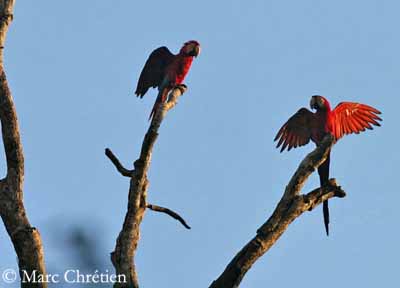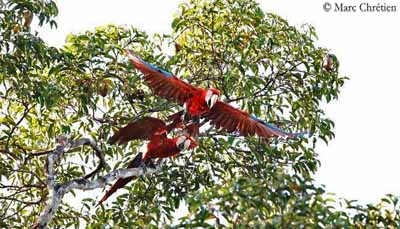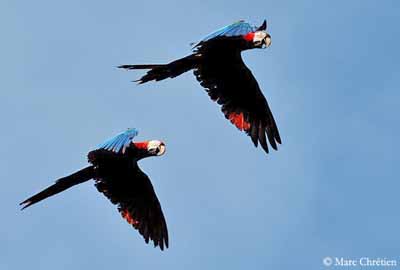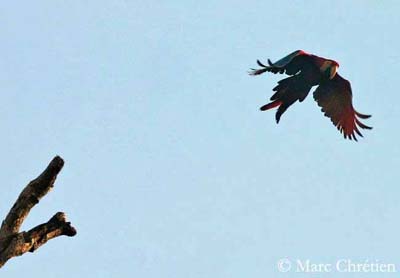
Red and Green Macaw
Ara chloropterus
Psittaciforme Order – Psittacidae Family
BIOMETRICS:
Length: 90-95 cm
Wingspan: 125 cm
Weight: 1050-1700 g
LONGEVITY: Up to 60-80 years
DESCRIPTION:
Very similar to the Scarlet Macaw (Ara macao), the Red-and-Green Macaw has darker red plumage and green upperwing, instead of yellow. In addition, the white face shows red feathered lines. It is the second largest parrot after the Hyacinth Macaw.
Adult male has red head and mantle. Median wing-coverts, scapulars and tertials are green. Back, rump and uppertail coverts are blue. The long tail is red with blue tips.
The underparts are dark red, except the blue undertail coverts.
The head is red with white bare face, showing red-feathered lines. The strong, hooked bill has horn-coloured upper mandible, with blackish sides of base. The lower mandible is blackish. The eyes are pale yellow. Legs and feet are grey.
Both sexes are similar.
Juvenile resembles adults with shorter tail. Its eyes are grey. The bill has grey lower mandible with white sides of the base.
PROTECTION / THREATS / STATUS:
Red-and-Green Macaw suffers some decline in some parts of the range, due to human disturbances.
The species is heavily trapped for illegal pet-trade. Habitat loss is another important threat.
This macaw is usually uncommon and the birds are often dispersed.
Fr: Ara chloroptère
All : Grünflügelara
Esp : Guacamayo Aliverde
Ital : Ara aliverdi
Nd : Groenvleugelara
Russe : Зеленокрылый ара
Sd : Mörkgrön ara
Port : Arara-vermelha
Photographs by Marc Chrétien
His website: MURINUS
Text by Nicole Bouglouan
Sources:
HANDBOOK OF THE BIRDS OF THE WORLD vol 4 by Josep del Hoyo-Andrew Elliott-Jordi Sargatal - Lynx Edicions - ISBN: 8487334229
PARROTS OF THE WORLD – An Identification Guide – by Joseph M. Forshaw – Princeton University Press – ISBN 0691092516
A GUIDE TO THE BIRDS OF COLOMBIA by Steven L. Hilty and William L. Brown - Princeton University Press – ISBN 069108372X
Arthur Grosset's Birds (Arthur Grosset)

VOICE: SOUNDS BY XENO-CANTO
Red-and-Green Macaw utters raucous “raw-aawk” repeated, and also screeching “ree-eeah”. It gives sometimes corvid-like calls ‘kraaah”.
When alarmed, it flies off while giving loud screeches.
HABITAT:
Red-and-Green Macaw lives in the forested areas of northern South America, such as rainforest in tropical northern areas, and deciduous and gallery forests along watercourses in southern parts.
This species needs large trees and cliff faces for nesting. It can be found up to 500 metres of elevation, sometimes up to 1500 metres in Panama.
RANGE:
Red-and-Green Macaw is found in the Orinoco and Amazon Basins, occupying almost the half north of South America, except the coastal regions. It lives in Central and South America, including Colombia, Panama, Venezuela, Guyana, Brazil and Trinidad.
BEHAVIOUR:
Red-and-Green Macaw is often seen alone, or in pairs, and also in small family groups. However, great numbers gather at clay-licks with other species. In some parts of the range, such as in south-eastern Peru, there are exposed banks of clay in the forest. Several species of parrots scrape off fine particles of clay with the bill, and swallow them. The clay helps these birds to detoxify themselves against the toxic substances included in seeds and unripe fruits which are their main food.

Red-and-Green Macaw is resident, only performing local and seasonal movements. It remains mainly high in the canopy of tall trees.
They may nest in hole in trees or in face cliffs where they dig tunnels in the sand-stone cliff.
Red-and-Green Macaw feeds on seeds, fruits and plant matter. The powerful bill allows the bird to crack open very hard shells, to get the pulp or the seed. They forage in trees.
It flies in the early morning and late evening, along the regular routes from the roosts to the feeding areas.
FLIGHT:
Red-and-Green Macaw performs direct flight with steady, shallow wing beats. The flight is strong and fast, that is surprising for such large parrot. This macaw is able to reach speeds of up to 55 km per hour.

REPRODUCTION:
Breeding season varies according to the location.
Pairs usually are monogamous and mate for life. Red-and-Green Macaw nests as in hole in tree, or in cliffs, according to the availability of the sites.
When nesting in sand-stone cliffs, the tunnel may be two metres deep, and several other tunnels join it. These other tunnels seem to be used as guards against intruders or to protect against heavy rainfalls. It may also use natural cavities in high cliffs.
Female lays 2 to 3 white eggs. Incubation lasts about 23 to 27 days. Young fledge at 12 weeks after hatching.
They remain with their parents for some weeks more. Both sexes rear the young.
In wild, Red-and-Green Macaw does not breed every year, and the reproductive success is low. Diseases and predation are the major threats for the young.
DIET:
Red-and-Green Macaw feeds on seeds, nuts, fruits, flowers and leaves. It needs to drink regularly during the day, in spite of the juicy fruits eaten. It also takes salt and minerals at clay-licks.
